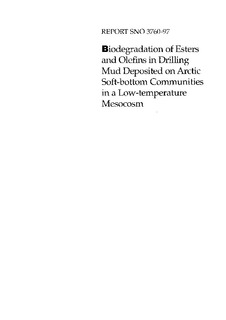Biodegradation of Esters and Olefins in Drilling Mud Deposited on Arctic soft-bottom communities in a low-temperature Mesocosm
Abstract
Discharge of chemicals from off-shore drilling operations represent a matter of concern for the oil industry and pollution control authorities world-wide. As the industry expands towards higher latitudes and greater depths, mud chemicals attached to bore hole cuttings may become deposited on sediments with ambient temperatures below 0 grader C. In order to assess the fate of the most recently developed ester- and olefin-based chemicals under such conditions, a comperative study was performed in the soft-bottom laboratory at Marine Research Station Solbergstrand on sediment communities transferred from Arctic and temperate deep fjord locations. The sediments were initially treated with four levels of cuttings (zero, low, medium and high dose) and maintained at simulated seabed conditions at -0.5 and 7 grader C, respectively. Biodegradation and effects on the sediment environment were assessed from observations of concentration change of organic phase and barium in the sediment, oxygen concumption rates, redox potentials and the macrobenthic community structure. During the three months experimental period, increasing rates of oxygen consumption in the Artic communities showed adaptation to degradation of the chemicals at rates no less than those observed in the Oslofjord communities. The Artic communities appeared, however, more sensitive to sulphide toxicity produced in high dose ester treatments, and no evidence was found to support the hypothesis that better availability to anoxic degraders would yield shorter sea-bed remediation times of areas contaminated with esters as compared to areas contaminated with C14-C18 olefins.

